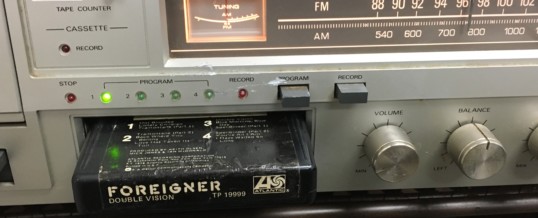
By the time I was getting into popular music around 8 or 9 years old, 8-track tape decks were in houses, cars, and even some restaurants. So, to me, the fact that they were everywhere meant that they must have always been in existence.
The truth is that the musical delivery system that launched in the mid-60s and carried me through junior high, high school, and part of college, was around for less than 20 years and was only popular in the United States. It never really caught on anywhere else in the world.
Cassette tapes also debuted in the 60s, but they were marketed as a home voice recording format, not for music. Cassettes would later be sold with music on them, and would contribute to the death of the 8-track tape.
For those who aren’t familiar with 8-tracks, it is a plastic cartridge that contains a loop of magnetic tape, quite similar to the tape used on reel-to-reel machines. As the loop of tape is turned by both a motor in the player and a roller inside the cartridge, it passes across a playback head. The head can be moved up and down by pressing the channel button, which allows you to play the four different tracks of music. Each track is stereo (two separate channels), hence the name: 8-track tape.
Sure, record albums and 45s were more common and young people had those too, but from the mid-1960s until the early 1980s, the 8-track offered teenagers a musical mobility that we needed.
Here’s why. Most parents controlled the home stereo system. Understandable, since they bought the big console units that could cost as much as a used car, so that meant that they chose what was listened to in the house.
As a teen, you could only take so much Bobby Goldsboro and Mystic Moods Orchestra before you needed to retreat somewhere for a Three Dog Night or Led Zeppelin fix.
It was the 8-track tape that allowed teens to take our music with us.
I mowed yards and worked at a bait shop one summer to save enough money to buy my own 8-track player for my bedroom. I also bought a pair of headphones.
This was a couple of years before I got my learners permit to drive, so at that point, I couldn’t leave home to listen to my music, but I could hole up in my part of the house, turn on my tunes, and tune out the world.
For the most part, my dad disliked my music. He made fun of the band names.
“Foghat? What’s a foghat, and who would wear one?” he asked.
“The Doobie Brothers. What’s a Doobie Brother?” he said as he laughed.
I honestly didn’t know what a foghat was, and I pretended I didn’t know anything about Doobie Brothers.
But in spite of the fact that he had zero interest in my music, he did like seeing me happy. He would buy lots of used 8-tracks from garage sales. I’m quite sure that he had little to no idea what he was buying me, but he would make deals on large quantities of tapes. Over the years, he brought me home boxes and boxes of great music.
I always suspected that his method for buying me tapes was simple. If he’d never heard of the band and their name sounded dumb to him, he would get it for me.
Consequently, I would often hit the jackpot with 8-tracks of Jefferson Airplane, The Moody Blues, Vanilla Fudge, Spooky Tooth, Jimi Hendrix, and many other excellent bands.
Ironically, it was because of my dad that I was introduced to many great artists that I otherwise might not have discovered on my own.
It was this collection of 8-tracks that formed the eclectic musical tastes my friends and I shared then, and still carry with us today.
When my buddies and I graduated from walking to driving, those tapes went everywhere with us. We each bought several 8-track tape cases and filled them to the brim. The cases would sit either in the backseat or in the front seat between us as we drove to school or work, cruised main street, or slowly rolled through the Pizza Hut parking lot trying to attract the girls’ attention.
I wish now that someone had told us that there were more effective ways to get the girls’ attention than creeping through the Pizza Hut parking lot wearing cheap sunglasses, with the windows down and Jimi Hendrix blaring.
Some of my best memories are of leaving a music store and sliding into the driver seat of my gold 1972 Oldsmobile Cutlass Supreme. I’d crank the car, roll down the windows, and then peel the cellophane from my new 8-track. Removing whichever tape was in the deck, I would push the new tape in until it seated, push the track button until it was on program one, and turn up the volume.
With my foot on the brake, I’d grab the shifter in the console and slide it into drive. Driving toward my next destination, the first song of the album would rise from the 6×9 speakers in the back deck and the small one in the dash.
Many of my now-favorite albums were heard for the first time this way. Boston, Supertramp, Foreigner, Bad Company, and yes, even Foghat and the Doobie Brothers.
These days, you listen to music from a computer cloud. Pretty boring, if you ask me.
Young people now will never be able to experience the uniqueness of unwrapping a new 8-track like it was a gift.
And it was a gift. It took my generation to the musical places we wanted to go, when we wanted to go, as often as we wanted to go there.
©2018 John Moore
John’s book, Write of Passage: A Southerner’s View of Then and Now, is available on Amazon.
Email John at John@TheCountryWriter.com.
FEB
2018
